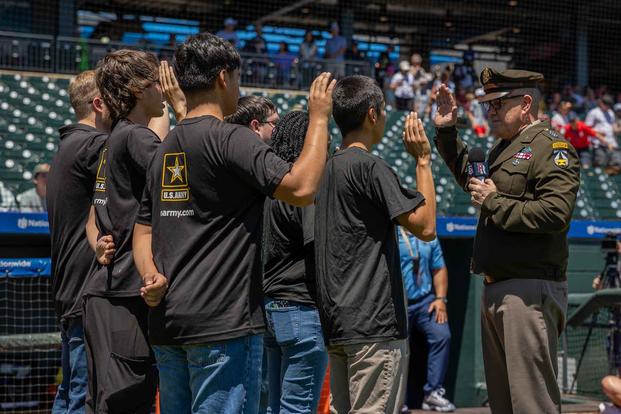CAF worsening recruitment woes
OPEN HOSTILITY TO WHITE MALES NOT HELPFUL - National Post - 10 Feb 2024 - JAMIE SARKONAK
Personnel numbers for the Canadian Armed Forces are at crisis levels, writes Jamie Sarkonak.
Like every army ever, the Canadian Armed Forces (CAF) have always been predominantly male. And, as a country with a majority of the population being of European descent, its members have been predominantly white. These facts should be uncontroversial.
But unlike every army ever, the CAF is using the identities of its historic membership to promote an ethos of guilt and shame within the institution. This isn’t fixing the present recruitment crisis and it’s doubtful that it ever will — but this approach has the firm support of scholarly military voices, the latest example coming to us from Paul Mitchell, a defence studies professor at the Canadian Forces College.
“The idea that our armed forces are ‘too woke’ misunderstands efforts to improve the work environment for historically under-represented groups,” Mitchell wrote this week for the Conversation. He argued that recruitment is falling among white males, and because the visible minority population is increasing, the military needs to turn its eyes elsewhere.
He was, in part, coming to the defence of the Canadian Military Journal which was criticized for its ideological slant last month. The journal’s summer issue was chockfull of identity-politic diatribes. In one article on the military’s festering “whiteness” problem, an author confirmed systemic racism was indeed happening based on a few qualitative interviews with non-white service members analyzed through the lens of racial, anti-western philosophy.
“I want to stress that the institutionalization of whiteness requires ongoing work by individuals who uphold white settler norms,” she wrote, widely assigning blame.
Another article suggested that military cultural norms should be shifted with ideological education. “Structural forms of power and privilege,” it argued, should guide lessons on colonialism, racism, sexism, misogyny, ableism, and heteronormativity; discomfort — that is, demoralization — should be embraced in learning.
The periodicals drenched in leftist theory, and our dear professor’s defence of it, aren’t just silly culture war musings that have no effect. Their effect can be found on the surface, in human resources materials and “anti-racism toolkits” that teach leftist racial ideology as fact. Deeper changes go to the heart of the CAF bureaucracy, which has bloated to include “diversity and inclusion champions,” affirmative action officers among its roles, and evaluations that examine a member’s “inclusive behaviours” as of 2022. Baked-in to all this is an understanding that masculinity, the “warrior ideal” and colonial history are fundamentally toxic to military culture.
But if there’s any institution that should be comfortable as a male-dominated space, it’s our military. It’s an institution whose job is to fight and defend, and, like any professional standing army in history, tends to draw from groups most capable of doing that: men. Men are more fight-prone for all sorts of reasons, and it’s an army’s job to channel and discipline these tendencies for the benefit of society as a whole. That doesn’t mean that women in the service should be left to fend for themselves — the opposite: they deserve to be treated with dignity like anyone else, and should expect any perpetrators of sexual harassment and assault to be fully prosecuted — but the institution doesn’t need to be de-masculinized to do that.
Similarly, the CAF should be able to take pride in its heritage as a descendant of the British system, while making sure to discipline anyone who harasses or attacks enlisted Indigenous people and minorities. It can do outreach to make itself known as an option to these groups, but leave the navel-gazing about unquantifiable systems of power and oppression to civil sociologists.
The sudden urgency to have the Canadian military reflect the nation’s demographics with perfect precision is odd, because this hasn’t been the case in about a century. A 2007 study observed that the primary recruiting pool consists of men who are: fit, aged 17 to 20, high-school educated, rural or small-city in origin and Caucasian in background. They also tend to come from families with a history of service. One can glean that the military was a good choice for those who wanted a stable career without having to dedicate his 20s to expensive education that doesn’t offer a clear path to a decent income.
“It is likely that the only time the Canadian Forces ever truly ‘reflected’ Canada was when conscription was in force during the two great global conflicts of the 20th century,” mused the study.
The author of the 2007 study concluded that demographic cherry-picking was probably a futile exercise. Unrealistically high identity targets proportionate to the population were unlikely to ever be met for a variety of reasons, including immigrant families’ tendency to encourage kids to go into professional fields of work with prospects for high income. It appears that while white, working-class rurals saw service as a class-booster, immigrants, especially more recent ones, often don’t. The inevitable falling-short of artificially high diversity targets, the author predicted, would “only entrench further the perception of organizational inertia and systemic racism” in the CAF and deter minority participation.
Academics like Mitchell, and his colleague Stephen Saideman, have insisted that a diversity-equity-and-inclusion culture change is key to raising recruitment and bolstering retention, but it’s hard to see how. Despite outreach efforts to newer recruiting pools and the hosting of cultural events that may appeal to them, personnel numbers are still at crisis levels, with the CAF being short 16,000 people. Recruitment hasn’t much improved in the past few years, either, with new members numbering at 10,300 in 2019-20, 4,300 in 2020-21, 8,100 in 2021-22 and 7,200 in 2022-23. Retention is poor, and people are leaving in greater numbers than they are joining.
“If all you think of the military is that it is for straight white dudes, then that’s not going to attract the 60 to 70 per cent of Canadians who are not straight white dudes,” Saideman told CTV last year.
It’s nothing new to reach out to recently-joined demographics to augment one’s forces: the Romans did it, the Brits did it, the French did it; it’s common sense. But importantly, this shouldn’t involve outright rejection of the recruiting base. Canada has foolishly done this: aside from embracing rhetorical attacks on “whiteness” and masculinity, it’s actually de-prioritized the enlisting of white men since at least 2018. In the U.K., a similar philosophy of alienation has been adopted only to see recruitment fall, with one British military leader telling staff to stop choosing “useless white male pilots” in 2021. (China doesn’t seem to have this complaint, having happily hired ex-british air force pilots to train their communist counterparts.)
Combine the CAF’S new cultural hostility to its recruitment base with just how much penny-pinching the military does, from meal reimbursements to monthly costof-living adjustments, it’s no wonder that fewer people want to join. Last year, housing benefits were clawed back from 7,700 members to be redistributed to new recruits. Members are leaving simply because they can’t afford the basics on a CAF salary.
Want a military that’s attractive to both the increasingly-turned-off traditional recruiting pool and immigrants? Offer prosperity — not the racial propaganda of the left.
MEN ARE MORE FIGHT-PRONE FOR ALL SORTS OF REASONS.







